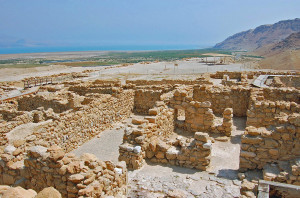Archaeologists searched near where the Bedouins found the first seven scrolls and eventually discovered more than 950 complete manuscripts and fragments in 11 additional caves, with Cave 4 yielding the largest cache. Some scrolls include at least portions of all the books of the Hebrew Scriptures except Esther, pushing the dates of the oldest known copies of those books back about 1,000 years. Others contain recognized books not in the Hebrew Scriptures, including Jubilees and 1 Enoch. The most interesting scrolls include previously unknown Jewish writings, some describing a mysterious “Teacher of Righteousness.” Scroll 4Q521, evoking Isaiah 61, says the Jewish Messiah “will heal the wounded, and revive the dead and bring good news to the poor.” That prediction is the earliest known writing linking the expected Messiah with the resurrection of the dead, a concept important to early Christians.
After finding the Dead Sea Scrolls, archaeologists excavated the nearby ruins of Qumran, unearthing a narrow room, ceremonial baths, pottery and inkwells. Some scholars are convinced Qumran was home to the Essenes, a strict first century Jewish sect, who wrote or copied the scrolls in their “scriptorium.” Qumran guides recite this idea, speculating that John the Baptist may have been an Essene. Others argue, with equal conviction, that Qumran was a villa, a fortress or perhaps a pottery factory having no connection with the scrolls, which they claim were hidden by people fleeing Jerusalem before its fall in 70 A.D. Others believe the scrolls were written at Qumran, but not by Essenes.
No matter who wrote the Dead Sea Scrolls, their discovery has added greatly to understanding the diversity of Jewish thinking about the Messiah at the time of Jesus. Their discovery has also spurred a new interest in the Essenes, known from the writings of first century historian Josephus but largely ignored because of the Biblical emphasis on the Sadducees and Pharisees.

Comments are closed.